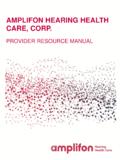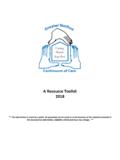Transcription of Clinical management of influenza and other acute ...
1 Clinical management of influenza and other acute respiratory illness in resource - limited settings: learning from the influenza pandemic (H1N1) 200920 21 October 2010 Geneva SwitzerlandWHO/HSE/GIP/ World Health Organization 2011 All rights reserved. Publications of the World Health Organization can be obtained from WHO Press, World Health Organization, 20 Avenue Appia, 1211 Geneva 27, Switzerland (tel: +41 22 791 3264; fax: +41 22 791 4857; e-mail: Requests for permission to reproduce or translate WHO publications whether for sale or for non-commercial distribution should be addressed to WHO Press, at the above address (fax: +41 22 791 4806; e-mail: designations employed and the presentation of the material in this publication do not imply the expression of any opinion whatsoever on the part of the World Health Organization concerning the legal status of any country, territory, city or area or of its authorities, or concerning the delimitation of its frontiers or boundaries.))
2 Dotted lines on maps represent approximate border lines for which there may not yet be full mention of specific companies or of certain manufacturers products does not imply that they are endorsed or recommended by the World Health Organization in preference to others of a similar nature that are not mentioned. Errors and omissions excepted, the names of proprietary products are distinguished by initial capital reasonable precautions have been taken by the World Health Organization to verify the information contained in this publication. However, the published material is being distributed without warranty of any kind, either expressed or implied. The responsibility for the interpretation and use of the material lies with the reader. In no event shall the World Health Organization be liable for damages arising from its publication contains the collective views of an international group of experts and does not necessarily represent the decisions or the policies of the World Health of acute respiratory illness in resource - limited settings | iContentsAcknowledgements iiAbbreviations and acronyms iii1 Background 12 The meeting Objectives Outcomes Agenda Participants 33 National experience Disease activity and impact on health-care systems Clinical epidemiology Clinical care National systems and response Communication 174 Key challenges of implementing Clinical guidance Country needs assessment questionnaire
3 Developing Clinical guidance in resource - limited settings Development of deployable kits of medical supplies and devices to manage hospitalized ARI in resource - limited settings Infection prevention and control 235 WHO approach: training to improve patient care at all levels Home-based care for pandemic influenza Community case management during an influenza outbreak training package Hospital-based training Critical care training Promoting oxygen use for pneumonia treatment 276 WHO action points 30ii | management of acute respiratory illness in resource - limited settingsAnnex 1 Agenda 31 Annex 2 List of participants 36 Annex 3 Oral statement on declarations of interest 42 Annex 4 Country questionnaire proforma 44 Annex 5 Calculation table for disposables and pulse oximetry for 100 severe pneumonia cases 47 TablesTable 1 South Africa (H1N1)
4 2009 fatality comorbidities 8 Table 2 South Africa HIV fatality comorbidity data 8 Table 3 Clinical outcome of (H1N1) patients by time of initiation of antiviral therapy, Argentina 12 Table 4 Requirements needed to strengthen treatment of acute respiratory illness , as identified by different countries 19 FiguresFigure 1 The 2009 influenza pandemic: key lessons learnt from countries 5 Figure 2 Argentina pandemic (H1N1) 2009 mortality rates according to age and gender 7 Figure 3 Severe acute respiratory illness surveillance incidence of infection of pandemic (a) (H1N1) 2009 and (b) H3N2 by HIV status, Soweto, South Africa 9 Figure 4 Streptococcus pneumoniae and influenza detection rates and total number of samples by week, South Africa, 2009 11 Figure 5 Early and effective primary care can forestall progression to severe disease 14 Figure 6 Bed status during surge of pandemic (H1N1) 2009 cases, Mongolia, 2010 16 AcknowledgementsThis document was prepared by Paula Lister, Justin Ortiz and Kathryn Sauven under the coordination of Nikki Shindo of the World Health Organization (WHO)
5 Global influenza would like to acknowledge the essential contributions of the participants at the technical meeting, and of WHO departments, including Health Action in Crisis/Emergency Preparedness and Capacity Building (HAC/EPC), Human Immunodeficiency Virus/Systems Strengthening and HIV (HIV/SSH), Family and Community Health Cluster/Child and Adolescent Health and Development (FCH/CAH) and Health Security and Environment/Global Alert and Response (HSE/GAR). We would also like to acknowledge other members of the Supporting Patient Care team of the WHO pandemic influenza functional response report was reviewed by Dr Iryna Bobrova, Dr Rosa Bologn, Dr Bin Cao, Dr Tawee Chotpityasunondh, Dr Santiram Dhakal, Dr Lena Napolitano, Dr Enkhtur Shonkhuuz, Dr Jagdish Chander Suri and Dr Juno would also like to acknowledge the support in this project of WHO staff: Vincent Ahove, Sylvie Briand, Meena Nathan Cherian, John Conly, Janet Diaz, Hien Doan, Sergey Eremin, Michelle Gayer, Madhu Ghimire, Sandra Gove, Benido Impouma, Matthew Lim, Joshua Mott, Lulu Muhe, Naoko Obara, Heather Papowitz, Charles Penn, Susan Piazza, Shamim Ahmad Qazi, Pilar Ramon-Pardo, Yu Togawa and Mari-Helene Vannson.
6 The final document was further strengthened by written comments, critiques and technical editing of previous drafts from Anna Bowman, Hilary Cadman, Rebecca Harris and Tim Nguyen. This project was supported in part by a grant from the United States Agency for International Development (USAID) and of acute respiratory illness in resource - limited settings | iiiAbbreviations and acronymsAIDS acquired immunodeficiency syndromeARDS acute respiratory distress syndromeARI acute respiratory infectionCAP community-acquired pneumoniaCHW community health workerETAT emergency triage assessment and treatmentGIP Global influenza Programme (of WHO)HCW health-care workerHIV human immunodeficiency virus ICU intensive care unitILI influenza -like illnessIMAI integrated management of adolescent and adult illnessIMCI integrated management of childhood illnessIPC infection prevention and controlIRDT influenza rapid diagnostic testMOH ministry of healthNGO nongovernmental organizationNIV noninvasive ventilationRSV respiratory syncytial virusSARI severe acute respiratory illnessSARS severe acute respiratory syndromeTB tuberculosisUNICEF United Nations Children s FundWHO World Health Organization1 | management of acute respiratory illness in resource - limited settings1 BackgroundPandemic (H1N1)
7 2009, the first influenza pandemic of the 21st century, reached all parts of the world within a year, causing epidemics of varying magnitude. During the pandemic period, the World Health Organization (WHO) received reports of over 18 000 laboratory-confirmed deaths due to infection with the virus; however, the actual death toll is likely to have been much higher1. The hospitalization rate was highest in children under 5 years of age, and particularly in those under 1 year of age. In contrast to seasonal influenza epidemics, most of the deaths from the 2009 influenza pandemic occurred in those under 60 years of age, up to half of whom had previously been healthy. Since the start of the 2009 influenza pandemic, WHO has been supporting countries in the area of patient care.
8 For countries with limited resources, WHO has developed information and training materials for several levels of health care at home and in the community, and in district and tertiary hospitals. Information on the pandemic disease was collected through WHO networks, including the network of clinicians at the front line. The training materials were developed based on existing WHO guidelines and manuals ( Hospital care for children2), complemented with information specific to pandemic (H1N1) early August 2010, the Director General of WHO announced that the world was moving into the post-pandemic period. During this period, however, the pandemic (H1N1) 2009 virus is expected to continue to circulate globally and cause disease among susceptible populations, especially in countries that did not go through the full (H1N1) 2009 epidemic.
9 Learning lessons from the pandemic (H1N1) 2009 experiences can help to strengthen health-care systems against future epidemics of influenza and of other epidemic-prone acute respiratory infections (ARIs). To address resource constraints in low- and middle-income countries, the following points raised by those attending the First Africa Flu Alliance meeting held in Morocco in June 20103 were considered when developing strategies to improve care of patients with ARI: further develop nurse-led primary care in communities through ARI training and the development of care and diagnostic kits; increase knowledge of influenza in the population through, for example, the mass media, community health workers (CHWs) and social mobilization campaigns; strengthen pneumonia care in hospitals through in-service training, delivery of equipment as a package ( oxygen, masks and pulse oximeter) and strategic planning that emphasizes funding and human The First Africa Flu Alliance Meeting was hosted by the WHO Global influenza Programme.
10 Plans to reduce influenza burden in Africa were discussed by health authorities, health partners and international health agencies. The meeting report is available at (accessed March 2011) management of acute respiratory illness in resource - limited settings | 22 The meetingThis document reports on a meeting convened by WHO in October 2010 titled Clinical management of influenza and other acute respiratory illnesses in resource - limited settings: Learning from (H1N1) 2009 influenza pandemic. ObjectivesThe overall goal for the meeting was to contribute to improved Clinical management of influenza and other ARI at all levels of health care during community transmission of pandemic influenza . Specific objectives developed to achieve the overall goal were to: review lessons learnt for the diagnosis and management of influenza from settings where resources are limited ; list key challenges of implementing Clinical guidance in resource - limited settings, and use this information for the further development of country-specific action items, to improve Clinical management of influenza at all or at focused levels of health care; introduce WHO information materials and training curricula to the participants, and assess whether any of these can fit into the action items identified by the above-mentioned exercise.
















